Technical and Economic Analysis of the Implementation of Selected Variants of Road Investment
Abstract
1. Introduction
2. Optimization Issues in Source Literature
- Multiple-attribute decision problem (MADP), for which there is a limited number of decision options, each of which has a specific, pre-determined and associated level of achievement of the features considered by the decision-maker to be significant, and the decision is made on their basis.
- Multiple-objective decision problem (MODP) that do not have a predetermined number of options with values of features specific to the problem; however, these problems have a set of quantifiable goals on the basis of which a decision is made and a set of well-defined restrictions on the value of decision variables of possible options.
- tn, understood as the normal time of implementation of the project, which corresponds to the lowest cost of its implementation (cumin);
- tgr understood as the cut-off time, i.e., the shortest possible duration of the project to which the cut-off cost (kgr) corresponds.
- accurate;
- mathematical (e.g., linear programming, dynamic programming, branch and bound method);
- heuristics (e.g., priority heuristics);
- metaheuristic (e.g., genetic algorithms).
3. Purpose of the Article
4. Description of the Existing State-Research Problem
4.1. Three Suggestions for Solving the Problem—Variants That Are the Subject of Research
- construction of a new roundabout on a main road at 30 m from the original intersection, partly on private and investor-owned land (option I)—see Figure 5;
- construction of a new roundabout on a main road at the place of the existing intersection, partly on private and investor-owned land (option II);
- construction of a new roundabout on a main road at the place of the existing intersection, partly on private and investor-owned land (option III).
4.1.1. Description of the Designed Condition—Option 1
4.1.2. Description of the Designed Condition—Option 2
4.1.3. Description of the Designed Condition—Option 3
5. Stages of the Optimization Process
- Indication of optimization criteria, i.e., determining the parameters that will be analyzed and modeled. In practice, most often these are: the cost of the whole project and its individual stages, times of their implementation, technology and quality of the proposed solutions, size and shape of the structure, scope of investment, standard of finishing the facility, assumed period of its use, costs related to maintenance and use, impact on environment.
- Determining the rank of selected optimization criteria, i.e., indicating their degree of importance for the entity performing the process.
- Establishment of initial boundary conditions, consisting in indicating actual conditions. These include, among others: location of the investment (e.g., urban conditions), terrain features (shape of the construction plot, soil and water conditions, availability of utilities), scope of the project (conceptual, construction), time limits for the implementation of the investment (resulting from the use of given technology of works, formal procedures), budget constraints (resulting from the method of financing the investment implementation or current prices on the construction market). Based on the indicated boundary conditions, it is possible to carry out a preliminary optimization process, e.g., costly construction investment. Its important element is, among other things, experience, and historical knowledge, allowing the identification of areas of potential reserves and savings without reducing the quality of works carried out.
- The proper optimization process, based on the construction cost estimate and investment schedule, considering the initial conditions of the investment. Iterative change of the initial parameters (in specified boundary ranges, while maintaining limitations resulting from regulations, standards, technologies, accepted constructional and material solutions), as a result, indicates the optimal solution. In the case of single-criteria optimization, the result of the process will be unambiguous; for cost optimization it is the total cost of construction, and for time optimization-the date of completion of the project. From a practical point of view, the process becomes significantly more complicated if several criteria are adopted as the basis for deciding. It should also be emphasized that not reducing every parameter, e.g., the cost of performing a given scope of works, will contribute to the reduction of the total investment cost. And so, for example, a change in technology or the use of cheaper material may result in longer works and an increase in indirect costs (related to, among others, maintaining buildings at the construction site). It should then be determined which criterion (criteria) is a priority for the entity performing the optimization.
6. Criteria Adopted for Optimization, Selection of the Optimal Variant
6.1. Cost Criterion
- the detailed method used;
- the Sekocenbud system price list has been used, rates and prices from the first quarter of 2020;
- current market prices of materials and information obtained from material producers were also used;
- the following works were taken into account: earthworks, demolition and demolition, foundation layers for the designed pavements, road equipment with road safety devices, land development after completed construction works, road connection with the section that is not subject to reconstruction;
- the cost of the division and purchase of real estate from private owners has been included. Based on the cost estimate prepared, considering the above assumptions, the cost of carrying out the works to be carried out under the three proposed variants was determined. The results are presented in Table 1.
6.2. Time Criterion
- the scope of works results from the project documentation prepared for the three considered variants;
- the works are carried out in the shortest possible time (using the method of uniform work, in some cases parallel and subsequent execution);
- 5 to 10 employees are employed to perform the works (depending on the scope and nature of technological processes);
- the time needed to complete formalities related to the division of land and purchase from private owners should be added to the times given;
- the basis for determining the tangible expenditure of labor and equipment is information obtained from construction cost estimates prepared using a detailed calculation method.
6.3. Social, Environmental, Security and Functional Criteria
7. Concluding Remarks
- The implementation of a construction investment includes several complex processes that require rational planning, including in terms of cost and time. Optimization of costs and construction time includes the balance of profits and losses, and as a result the indication of the optimal solution considering the two main parameters of the investment project. In practice, however, it is important that before making the final investment decision, a broad analysis, also considering criteria of a different nature (social, environmental, etc.) is necessary. In some cases, these criteria may significantly influence the awarding entity’s decision regarding the choice of investment implementation option.
- Due to the range of possible decisions and actions, the process of solution optimization considering various criteria should be started as early as possible, i.e., already at the design stage. This approach allows more possible options and a perspective and comprehensive look at the investment to be obtained. At this stage, optimization can include the size and shape of the structure, type of material and technology of the object or proposed structural solutions. Analyses related to the optimization of solutions, carried out at the design stage, seem rational also from the point of view of the efficiency of spending. It should be emphasized that as the scope and size of investments increase, the complexity of analyses increases, but at the same time the possibilities for optimizing solutions increase.
- Due to the complexity of the construction process, in order to properly optimize (taking into account cost, time, functionality, safety, environmental, social criteria), extensive knowledge and extensive experience of the team responsible for carrying out this process (architects, structural and installation designers, engineers, experts in the field of cost analysis, technology and organization of construction works, lawyers, logistics specialists) are necessary. Optimizations of solutions should be carried out many times and at various stages of preparation, sometimes also the implementation of investments, considering current circumstances, but also the direction and scope of forecast changes in the long run. The recommended solution (option 1) takes into account the long-term forecast of road traffic intensity, as well as other parameters ensuring the maintenance of road safety at the highest level, and consequently a reduction in the number of dangerous road incidents and personal, material, environmental and economic losses.
- The analyses presented in the article and the proposed solution for the reconstruction and modernization of the intersection (option 1) rationally consider current and future transport needs, expectations of road users and social requirements. In a broader context, this also meets the objectives of infrastructure sustainability, with a focus on its reliability, user safety and limited environmental impact.
- It is important to forecast the direction and extent of future changes in relation to the needs of safe and economical transport, expected standards of quality of use (functionality, capacity and technical parameters) and safety of road participants (smooth transition, reduction of collisions and accidents and negative impact on the environment). The presented example and the proposed scope of actions envisaged for implementation under option 1, supported by the analysis of costs and time, can be considered in a broader context as a proposal of actions taking into account the long-term vision of sustainable development of infrastructure in urban and extra-urban areas.
Author Contributions
Funding
Conflicts of Interest
References
- Grzyl, B.; Kristowski, A.; Jamroz, K.; Gobis, A. Methods of estimating the cost of traffic safety equipment’s life cycle. In Proceedings of the XI International Road Safety Seminar GAMBIT, Gdansk, Poland, 17–18 November 2016; EDP Sciences: Les Ulis, France, 2017. Available online: https://doi.org/10.1051/matecconf/201712202003 (accessed on 12 April 2020).
- Kowalski, D.; Grzyl, B.; Kristowski, A. The cost analysis of corrosion protection solutions for steel components in terms of the object life cycle cost. Civ. Environ. Eng. Rep. 2017, 26, 5–13. [Google Scholar] [CrossRef]
- Jamroz, K.; Budzyński, M.; Kustra, W.; Michalski, L.; Gaca, S. Tools for road infrastructure safety management–Polish experiences. Transp. Res. Procedia 2014, 3, 730–739. [Google Scholar] [CrossRef]
- Kustra, W.; Jamroz, K.; Budzynski, M. Safety PL—A support tool for road safety impact assessment. Transp. Res. Procedia 2016, 14, 3456–3465. [Google Scholar] [CrossRef]
- Kristowskia, A.; Grzyl, B.; Kurpińska, M.; Pszczoła, M. The rigid and flexible road pavements in terms of life cycle costs. In Proceedings of the Creative Construction Conference, Ljubljana, Slovenia, 30 June–3 July 2018; pp. 226–233. Available online: https://repozitorium.omikk.bme.hu/bitstream/handle/10890/5692/CCC2018-030.pdf?sequence=1 (accessed on 5 April 2020). [CrossRef]
- Plebankiewicz, E.; Zima, K.; Wieczorek, D. Life cycle cost modelling of buildings with consideration of the risk. Arch. Civ. Eng. 2016, 62, 149–166. [Google Scholar] [CrossRef][Green Version]
- Plebankiewicz, E.; Meszek, W.; Zima, K.; Wieczorek, D. Probabilistic and Fuzzy Approaches for Estimating the Life Cycle Costs of Buildings under Conditions of Exposure to Risk. Sustainability 2020, 12, 226. [Google Scholar] [CrossRef]
- Gobis, A.; Jamroz, K.; Jeliński, Ł. Zastosowanie metody szacowania kosztów cyklu życia w zarządzaniu infrastrukturą transportową. Pr. Nauk. Politech. Warsz. Transp. 2019, 126, 5–14. (In Polish) [Google Scholar]
- Kozik, R.; Leśniak, A.; Majka, M. Application of multi-criteria analysis method for thermal insulation solutions selection. In Proceedings of the AIP Conference Proceedings 2116, Rhodes, Greece, 13–18 September 2018; p. 180010. Available online: https://aip.scitation.org/doi/abs/10.1063/1.5114167 (accessed on 10 April 2020).
- Chang, C.H.; Lin, J.J.; Lin, J.H.; Chiang, M.C. Domestic openend equity mutual fund performance evaluation using extended TOPSIS method with different distance approaches. Expert Syst. Appl. 2010, 37, 4642–4649. [Google Scholar] [CrossRef]
- Roszkowska, E. Teoria Podejmowania Decyzji a Teorie Zarządzania. Optim. Studia Ekon. 2009, 44, 97–119. (In Polish) [Google Scholar]
- Fridgeirsson, T.; Rosłon, J. Optymalizacja Procesów Budowlanych; Biblioteka Menedżerów Budowlanych, ERASMUS+ 2015-1-PL01-KA202-016454; Wydział Inżynierii Lądowej Politechniki Warszawskiej: Warszawa, Polska, 2017; Volume 12, (In Polish). Available online: http://www.aeebc.org/clomec%20manuals/CLOEMC-IV-manuals/M22_PL_FINAL.pdf (accessed on 1 April 2020).
- Kowalczyk, Z. Metody Matematyczne w Ekonomice, Organizacji i Zarządzaniu w Budownictwie; Wydawnictwo Politechniki Gdańskiej: Gdańsk, Poland, 1982. (In Polish) [Google Scholar]
- Zhou, J.; Love, P.E.; Wang, X.; Teo, K.L.; Irani, Z. A review of methods and algorithms for optimising construction scheduling. J. Oper. Res. Soc. 2013, 64, 1091–1105. [Google Scholar] [CrossRef]
- Hejducki, Z.; Podolski, M. Harmonogramowanie Przedsięwzięć Budowlanych z Zastosowaniem Algorytmów Metaheurystycznych; Zeszyty Naukowe Biblioteka Menedżerów Budowlanych, ERASMUS+ 2015-1-PL01-KA202-016454 63; Wyższa Szkoła Oficerska Wojsk Lądowych im. gen. T. Kościuszki: Wrocław, Poland, 2012; pp. 68–79, (In Polish). Available online: http://yadda.icm.edu.pl/baztech/element/bwmeta1.element.baztech-article-BPW6-0031-0007 (accessed on 15 February 2020).
- Anysz, H. The profit as in-company evaluation of the construction site effectiveness. In Proceedings of the RSP 2017: XXVI R-S-P Seminar 2017 Theoretical Foundation of Civil Engineering, Warsaw, Poland, 21–25 August 2017; EDP Sciences: Les Ulis, France, 2017; Volume 117, p. 9. Available online: https://doi.org/10.1051/matecconf/201711700009 (accessed on 7 April 2020).
- Nguyen, A.T.; Sigrid, R.; Philippe, R. A review on simulation-based optimization methods applied to building performance analysis. Appl. Energy 2014, 113, 1043–1058. [Google Scholar] [CrossRef]
- Jaśkowski, P.; Sobotka, A. Scheduling construction projects using evolutionary algorithm. J. Constr. Eng. Manag. 2006, 132, 861–870. [Google Scholar] [CrossRef]
- Książek, M.V.; Nowak, P.O.; Kivrak, S.; Rosłon, J.H.; Ustinovichius, L. Computer-aided decision-making in construction project development. J. Civ. Eng. Manag. 2015, 21, 248–259. [Google Scholar] [CrossRef]
- Ucar, A.; Inalli, M. Exergoeconomic analysis and optimization of a solar-assisted heating system for residential buildings. Build. Environ. 2006, 41, 1551–1556. [Google Scholar] [CrossRef]
- Wright, J.A.; Loosemore, H.A.; Farmani, R. Optimization of building thermal design and control by multi-criterion genetic algorithm. Energy Build. 2002, 34, 959–972. [Google Scholar] [CrossRef]
- Liao, T.W.; Egbelu, P.J.; Sarker, B.R.; Leu, S.S. Metaheuristics for project and construction management–A state-of-the-art review. Autom. Constr. 2011, 20, 491–505. [Google Scholar] [CrossRef]
- Belniak, S.; Leśniak, A.; Plebankiewicz, E.; Zima, K. The influence of the building shape on the costs of its construction. J. Financ. Manag. Prop. Constr. 2013. Available online: https://www.researchgate.net/profile/Krzysztof_Zima/publication/263332537_The_influence_of_the_building_shape_on_the_costs_of_its_construction/links/5547c4d40cf2b0cf7ace940e/The-influence-of-the-building-shape-on-the-costs-of-its-construction.pdf (accessed on 8 April 2020). [CrossRef]
- Ramzi, O.; Krarti, M. Building Shape Optimization Using Neural Network and Genetic Algorithm Approach. Ashrae Trans. 2006, 112, 484–491. [Google Scholar]
- Gmina Bytow, SIWZ. (In Polish). Available online: www.bip.bytow.com.pl/a,18499,opracowanie-dokumentacji-projektowo-kosztorysowej-budowy-drog-gminnych-ul-gornej-ul-brzozowej-i-ul-s.html (accessed on 31 October 2019).
- Pawelska-Mazur, M.; Kurpińska, M. Fibres from recycled post-consumer tyres for concrete reinforcement. In Current Scientific Challenges in Concrete and Steel Structures and Concrete Technology; Korzeniowski, P., Abramski, M., Eds.; Gdańsk University of Technology Faculty of Civil and Environmental Engineering: Gdańsk, Poland, 2011; pp. 121–128. [Google Scholar]
- Żukowska, J.; Budzyński, M. Road safety system in Poland. J. KONBiN 2008, 4, 491–505. [Google Scholar]
- Wachnicka, J. Identification and comparative analysis of factors influencing road safety in US regions and in Polish voivodeships. Transp. Probl. 2013, 8, 53–66. Available online: https://www.infona.pl/resource/bwmeta1.element.baztech-1f56e906-613e-410a-94f9-a15b75234477 (accessed on 5 April 2020).
- Dokumentacja Geotechniczna—Badania Podłoża Gruntowego; MS Geotechnika: Bytów, Poland, 2018; pp. 1–32, (In Polish). Available online: https://www.bip.bytow.com.pl/a,18499 (accessed on 25 May 2020).
- Jakubczyk-Gałczyńska, A.; Apollo, M.; Szczepański, M. Czynniki ryzyka wypadków podczas prowadzenia robót drogowych. Miękkie techniki zarządzania bezpieczeństwem pracy. TTS Tech. Transp. Szyn. 2012, 9, 1253–1261. (In Polish) [Google Scholar]
- Młodożeniec, W. Budowa Dróg Podstawy Projektowania; BEL Studio: Warsaw, Poland, 2014. (In Polish) [Google Scholar]
- Kristowski, A.; Grzyl, B.; Kowalski, D. The Analysis of the Influence of the Corrosion Protection Method of Selected Steel Elements on the Steel Structure Life Cycle Costs; Diamond Congress Ltd.: Budapest, Hungary; Budapest University of Technology and Economics: Budapest, Hungary, 2018; pp. 220–225. [Google Scholar]
- Grzyl, B.; Miszewska, E.; Apollo, M. The life cycle cost of a building from the point of view of environmental criteria of selecting the most beneficial offer in the area of competitive tendering. In Proceedings of the 9th Conference on Interdisciplinary Problems in Environmental Protection and Engineering EKO-DOK 2017, Boguszów-Gorce, Poland, 23–25 April 2017; EDP Sciences: Les Ulis, France, 2017; pp. 1–8. Available online: https://doi.org/10.1051/e3sconf/20171700028 (accessed on 9 April 2020).

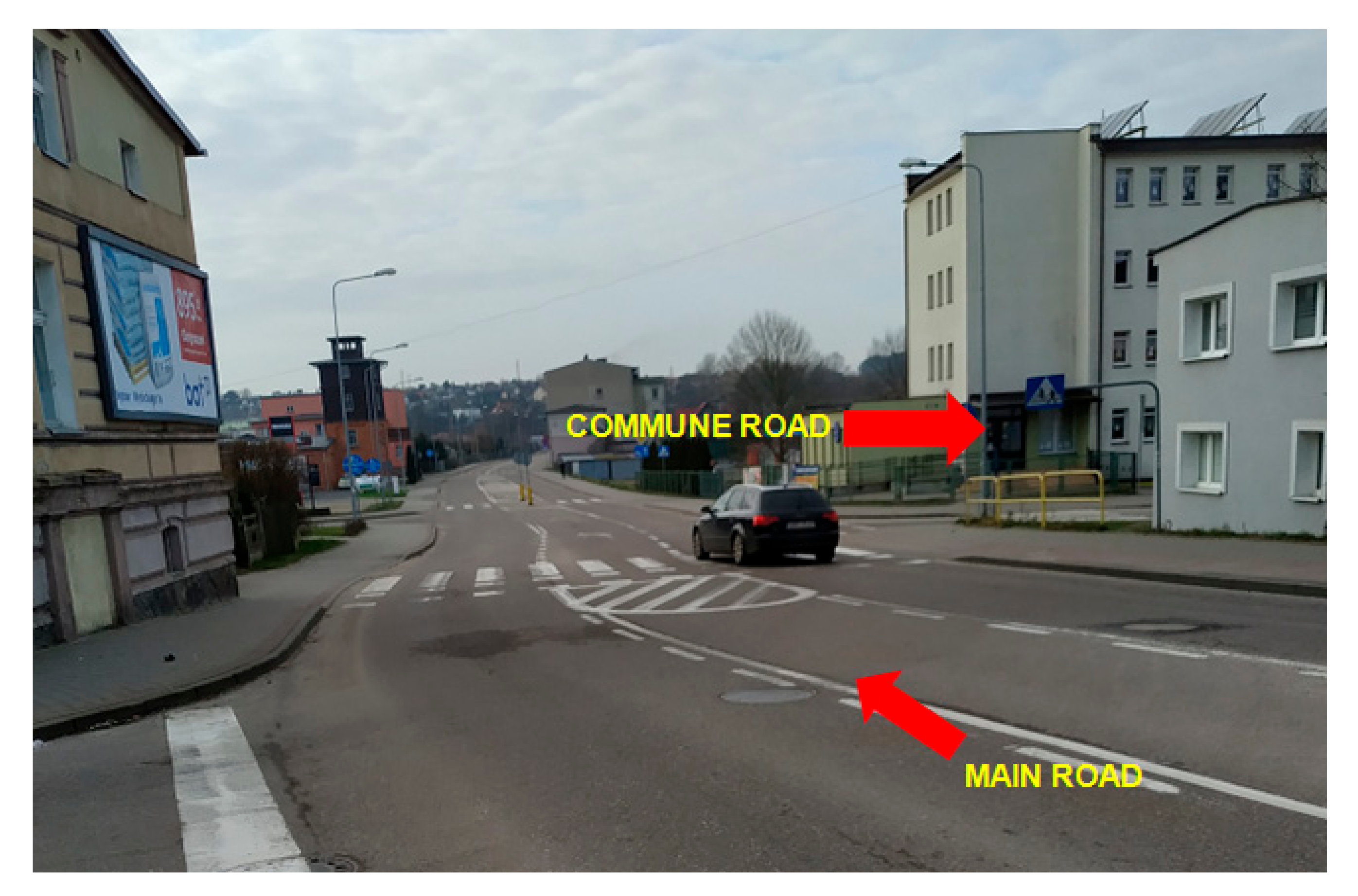
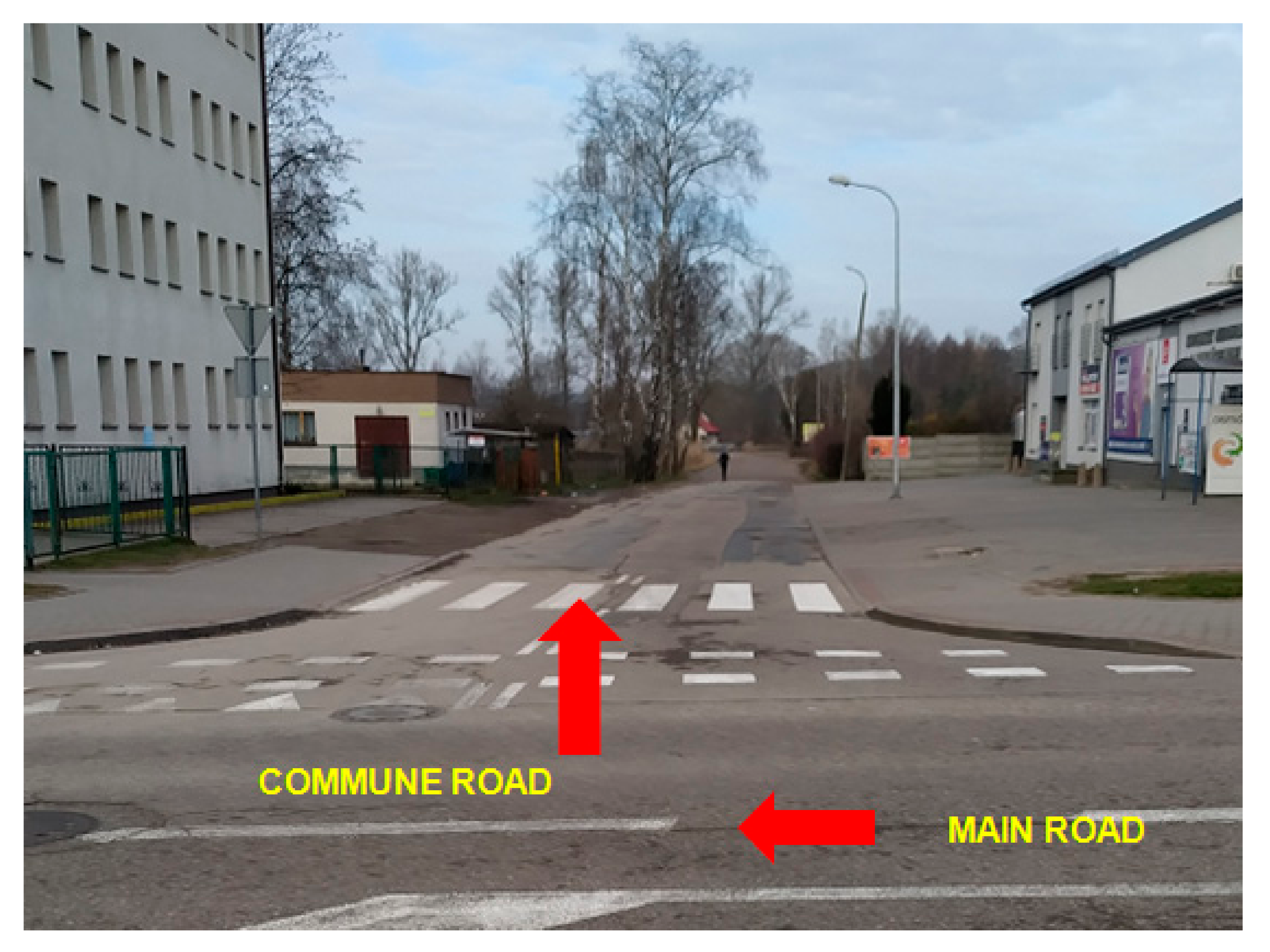

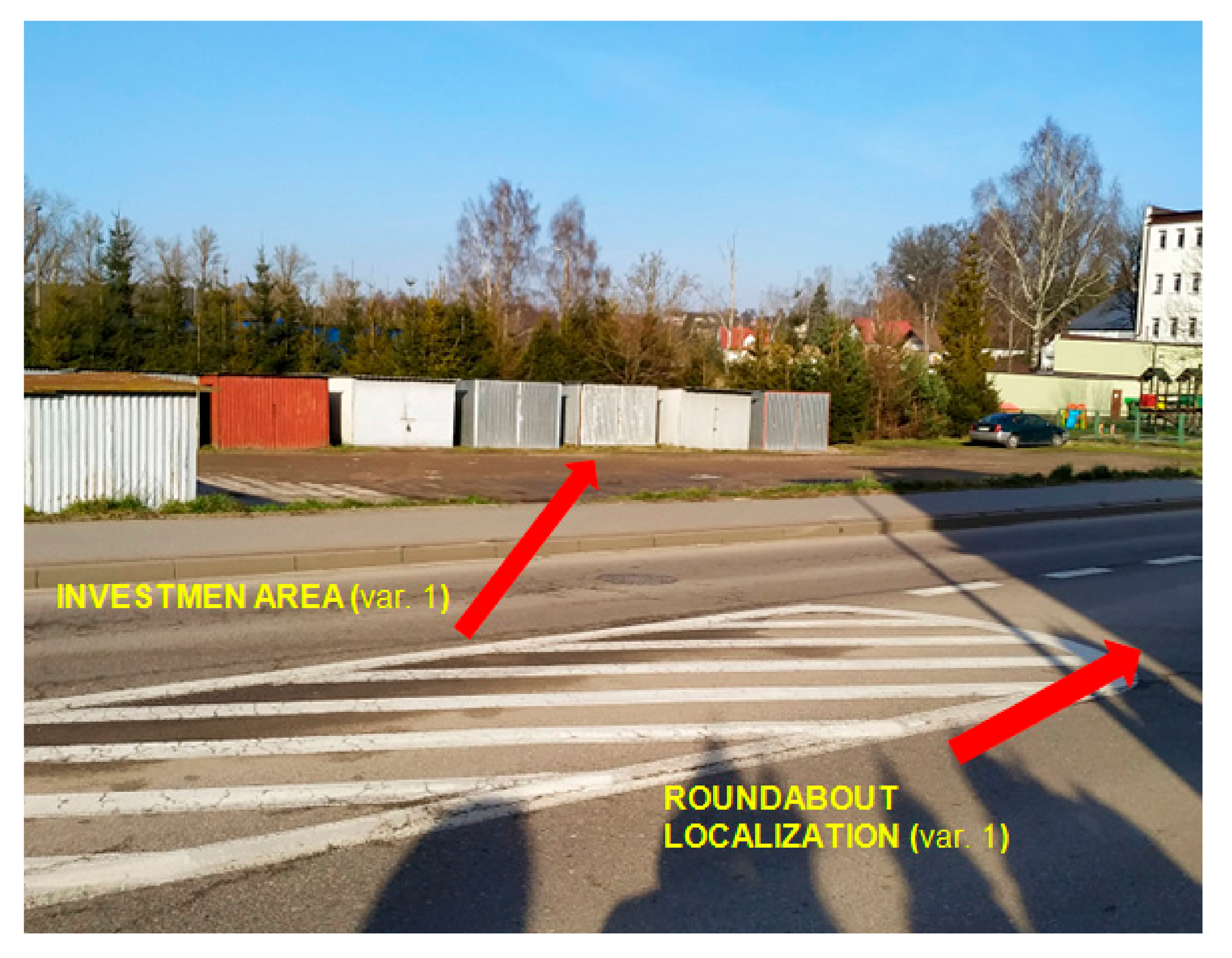
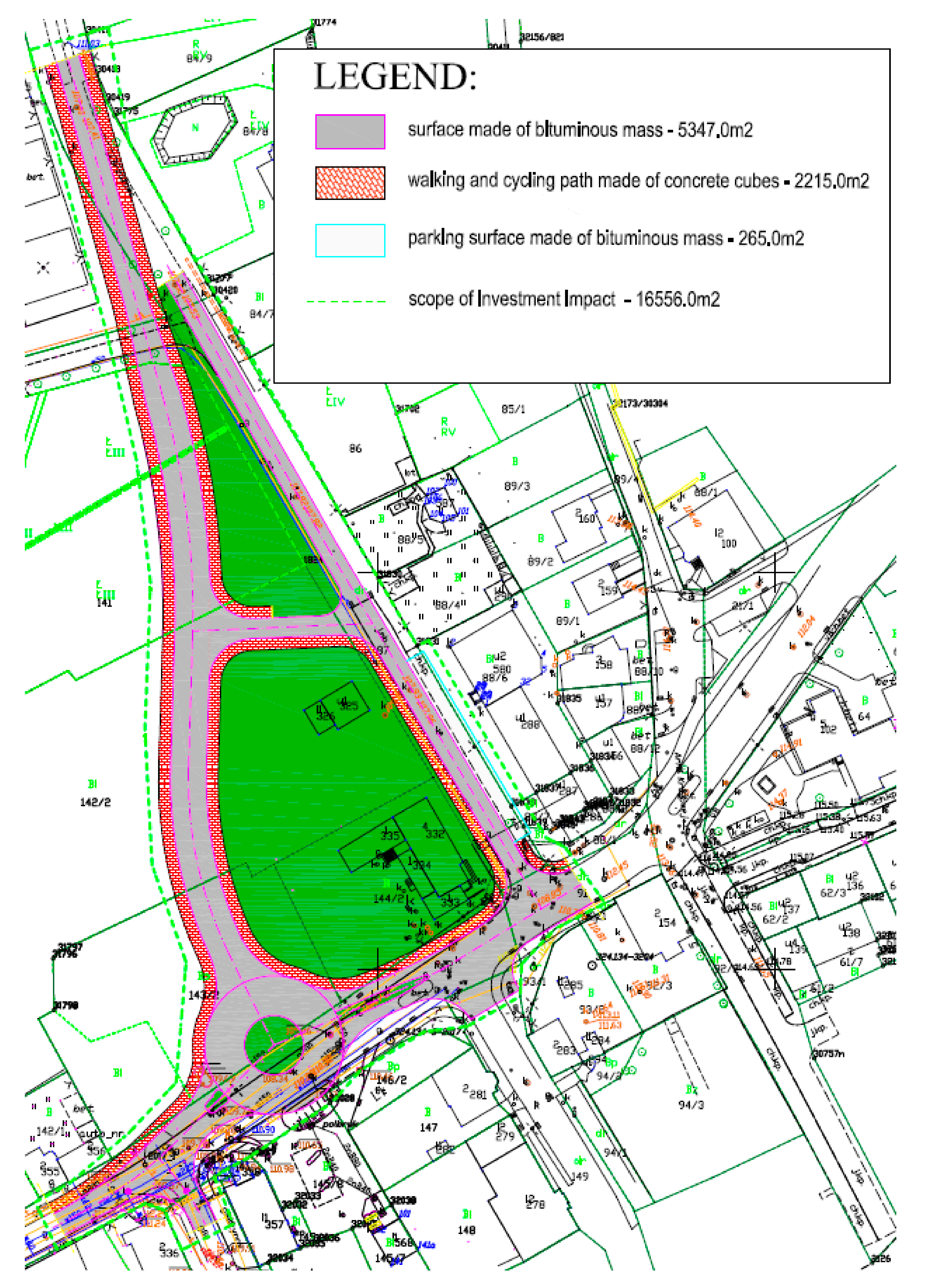



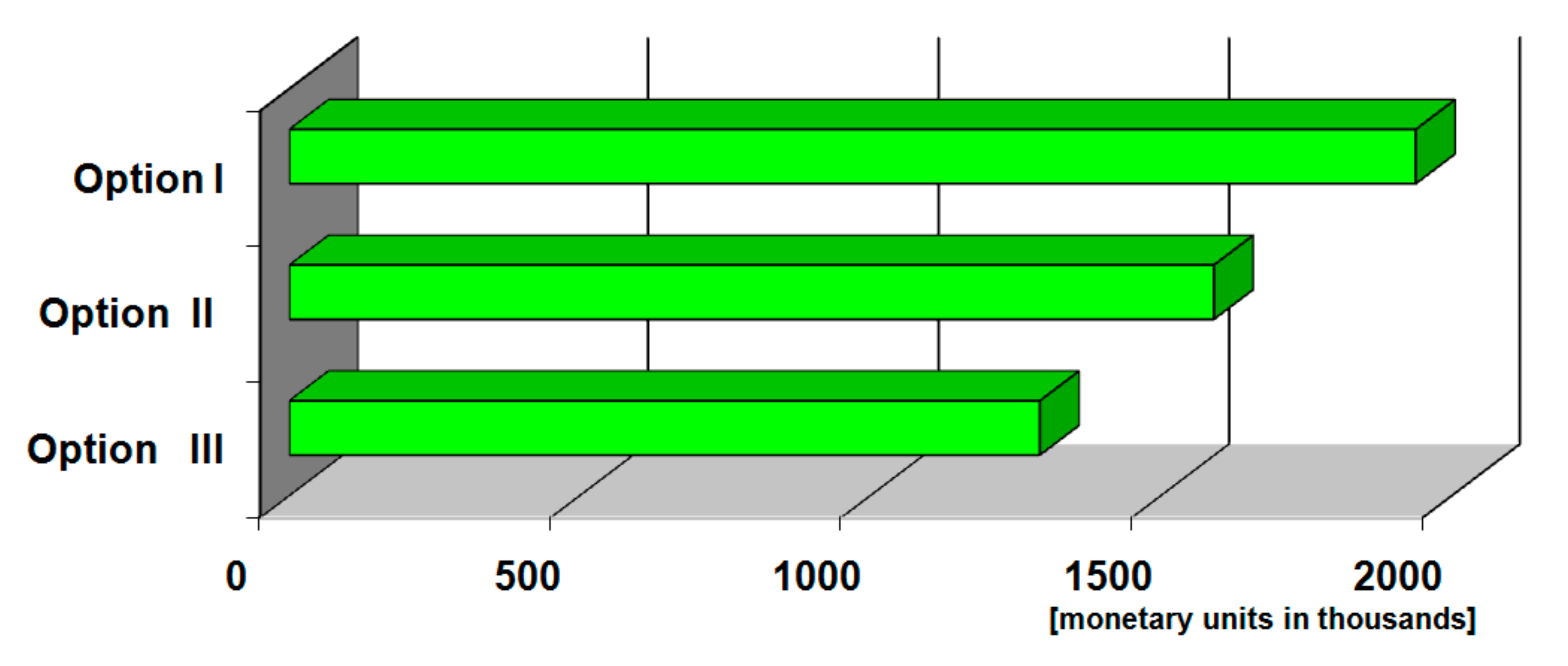
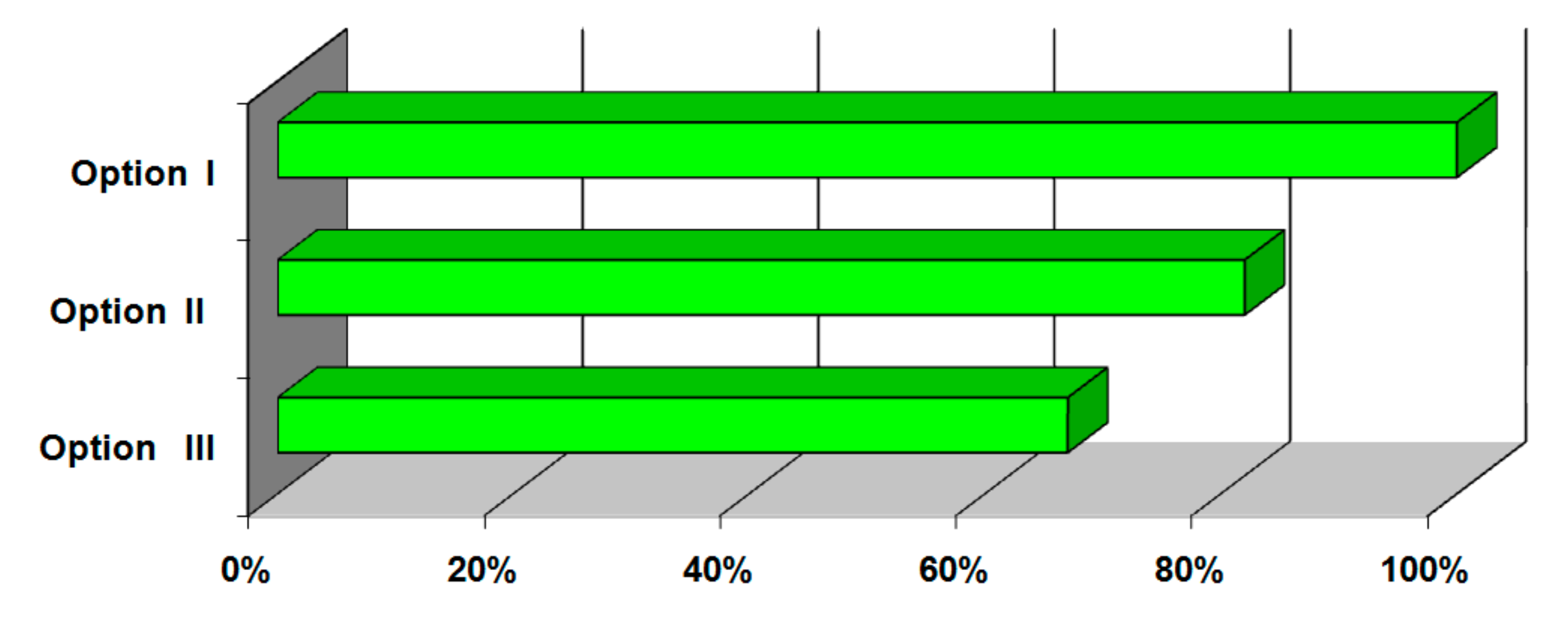

| Option 1 | Option 2 | Option 3 |
|---|---|---|
| 1,937,994.45 * | 1,590,618.51 * | 1,291,222.97 * |
| Option 1 | Option 2 | Option 3 |
|---|---|---|
| 272 * | 165 * | 178 * |
| Option 1 | Option 2 | Option 3 |
|---|---|---|
| the slightest interference in the buildings around the road, no need to demolish facilities located in the future investment, the most noticeable effects-there will be a significant flow of vehicles and pedestrians, the highest level of functionality and security of the solution. providing additional safety to municipal road users, by reducing traffic. | similarity of traffic organization to existing. | the least interference in neighboring areas, least logistically troublesome scope of work to be carried out, elimination of potential causes of conflicts with owners of areas adjacent to the road, no need for extensive demolition and demolition works. relatively lowest implementation cost compared to options 1 and 2. |
| Option 1 | Option 2 | Option 3 |
|---|---|---|
| the need for major reconstruction of the existing road structure, interference in many private plots (divide them, buy them out and change their qualifications), the long time needed for the division and purchase of plots from private owners. the highest investment cost compared to options 2 and 3. | the need to purchase plots around the planned roundabout from private owners, the need to make numerous demolitions and demolitions of existing-currently used residential buildings, high costs associated with acquiring new areas, the long time needed for the division and purchase of plots from private owners and the demolition and demolition of buildings. | poorly synchronized traffic lights will cause congestion on access roads, preservation of the existing organization of pedestrian and cyclist traffic will cause an additional safety risk due to the increase in road capacity and traffic volume, reconstruction of the existing road system does not solve most of the contracting authority’s problems in this area. |
© 2020 by the authors. Licensee MDPI, Basel, Switzerland. This article is an open access article distributed under the terms and conditions of the Creative Commons Attribution (CC BY) license (http://creativecommons.org/licenses/by/4.0/).
Share and Cite
Szczepański, M.; Grzyl, B. Technical and Economic Analysis of the Implementation of Selected Variants of Road Investment. Buildings 2020, 10, 97. https://doi.org/10.3390/buildings10060097
Szczepański M, Grzyl B. Technical and Economic Analysis of the Implementation of Selected Variants of Road Investment. Buildings. 2020; 10(6):97. https://doi.org/10.3390/buildings10060097
Chicago/Turabian StyleSzczepański, Marcin, and Beata Grzyl. 2020. "Technical and Economic Analysis of the Implementation of Selected Variants of Road Investment" Buildings 10, no. 6: 97. https://doi.org/10.3390/buildings10060097
APA StyleSzczepański, M., & Grzyl, B. (2020). Technical and Economic Analysis of the Implementation of Selected Variants of Road Investment. Buildings, 10(6), 97. https://doi.org/10.3390/buildings10060097





